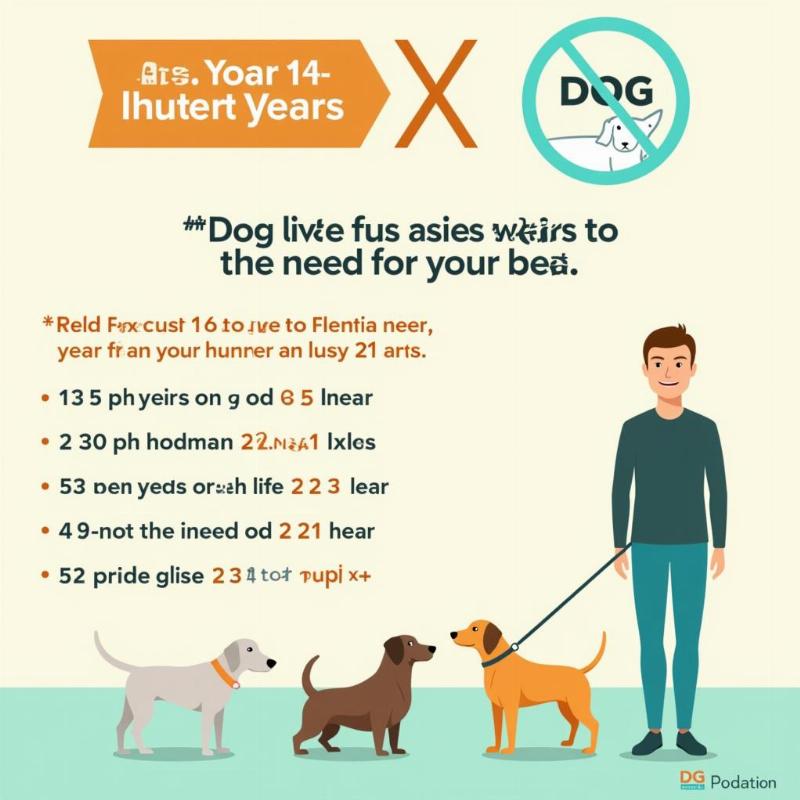Calculating when you and your dog reach the same “age” is a fun thought experiment, though it’s not a precise science. While the “7 dog years to 1 human year” rule is widely known, it’s an oversimplification. This article dives into a more accurate way to calculate when you and your furry friend reach a comparable stage of life, considering size and breed.
 Calculating Dog Age in Human Years
Calculating Dog Age in Human Years
Understanding Dog Age vs. Human Age
The idea of matching human and dog ages is more about comparing life stages than actual chronological years. A one-year-old Great Dane, for example, has reached a level of physical maturity closer to a human teenager than a human toddler. A small dog, on the other hand, might be closer in maturity to a pre-teen.
Factors Influencing the Calculation
Several factors contribute to the complexity of comparing dog and human ages:
- Size and Breed: Larger dogs tend to age faster than smaller breeds. Giant breeds often have shorter lifespans compared to toy breeds.
- Individual Variation: Just like humans, individual dogs age at slightly different rates, influenced by genetics, health, and lifestyle.
A More Accurate Calculation
The American Veterinary Medical Association (AVMA) provides a more nuanced approach to comparing dog and human ages. They explain that dogs mature rapidly in the first two years, then the aging process slows down. The AVMA acknowledges that calculating a dog’s age in human years is not an exact science due to variability between breeds and individuals.
Calculating Your “Shared” Age
While there’s no single perfect formula, here’s a general guideline:
- First Two Years: A dog’s first year is equivalent to roughly 15 human years. The second year adds another 9, bringing a two-year-old dog to a maturity level similar to a 24-year-old human.
- Subsequent Years: For each year after two, add about four or five human years for smaller breeds and five to seven for larger breeds.
Using this method, you can estimate when your dog and you might share a similar “age.” For example, a small dog who is five years old is roughly equivalent to a 36-year-old human.
Why This Calculation Matters
Understanding your dog’s life stage helps you tailor their care appropriately. A senior dog will have different needs than a puppy, just like a senior human has different needs than a child. This understanding guides decisions about exercise, diet, and veterinary care.
Conclusion
Calculating when you and your dog are the same “age” is more than just a fun exercise. It offers valuable insights into your dog’s life stage, allowing you to provide the best possible care and strengthen your bond. Remember, regular check-ups with your veterinarian are essential for personalized guidance based on your dog’s specific breed, size, and individual needs.
FAQ
- Is the “7 dog years to 1 human year” rule accurate? No, it’s an oversimplification. Dogs age much faster in the first two years.
- How can I best determine my dog’s age in human years? Use the AVMA guidelines, considering your dog’s breed and size.
- Why is it important to understand my dog’s life stage? It helps you tailor their care appropriately to their needs.
- What factors affect a dog’s aging process? Size, breed, genetics, health, and lifestyle all play a role.
- How often should I take my dog to the vet? At least annually, and more frequently as they age.
Beautdogs.us is your premier resource for all things dog-related in the US. We offer expert advice on dog breeds, care, and products, empowering both new and experienced dog owners to provide the best possible lives for their canine companions. From puppyhood to senior years, we’re here to help you navigate every stage of your dog’s life. Contact us today! Email: [email protected] Phone: +1 501-555-7529. Visit Beautdogs.us for more valuable information and resources.